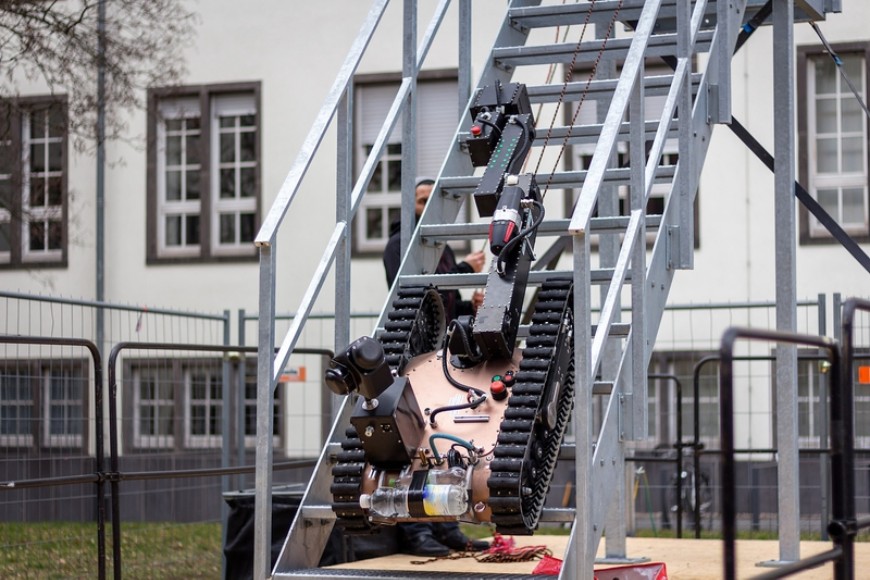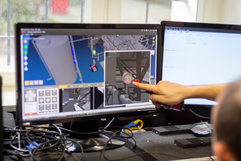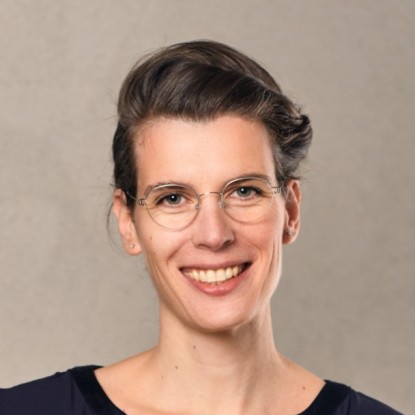Robot „Argonaut“ trains in harsh weather conditions for the finals in France
Stage 1: Preparation
07.03.2017 von Jessica Bagnoli / Natalie Wocko, Translation: Natalie Wocko

A robot, developed by the Department of Computer Science of TU Darmstadt, competes in the final of the international ARGOS Challenge for intelligent inspection robots on oil and gas platforms for the 500,000 Euro price. The challenge was launched by the French company TOTAL. From March 13 to 17, the Argonaut developers from Darmstadt and their cooperation partners from Vienna will have to prove themselves against four other teams in Pau, France. They are currently practicing around the clock in the laboratory and on campus.
The „Argonauts“ team from the SIM Institute (Simulation, Systems Optimization and Robotics) is working on full-speed as their robot takes part in the final of the ARGOS Challenge (Autonomous Robot for Gas and Oil Sites) in Pau, France, between March 13 to 17. The French multinational integrated oil and gas company TOTAL called for the development of an autonomous mobile remote inspection robot, which is able to inspect and monitor the area of a multistory oil and gas platform on its own under varying conditions, in order to decrease the high risks for platform operators.

During the five-day challenge, twelve members of the developers' team, which consists of computer scientists and students from TU Darmstadt and coworkers of the robotics company taurob GmbH, have to demonstrate that their robot is able to inspect an industrial oil and gas platform autonomously. In the SIM laboratory, possible task assignments are transmitted to the robot, which a staff member supervises remotely on a monitor. While the robot checks manometers, level gauges and valve positions with the help of its cameras and sensors during an inspection round, it also has to detect unexpected obstacles, heat sources, gas leaks as well as the general platform alarm. The robot is expected to react accordingly and to communicate this data to a human operator who monitors the mission. The operator should be able to intervene and take over teleoperation manually at any time, whereas the robot has to autonomously end the mission afterwards. During teleoperation, certain assistance functions (by means of sensors and cameras) are activated which are supposed to automatically prevent collisions with the site and with the people moving around the platform.
To master these requirements, the robot drives around a test site in the basement of the old main building and the outdoor area at the Computer Science Department, while the developers prepare it for all contingencies, such as stair climbing in all weathers. A small group of spectators gathered last Thursday to oversee the Argonaut during one of these test runs. Raphael Brandtner, a fellow campaigner from taurob GmbH, has traveled from Vienna to examine the Argonaut's progress. While Dr. Alberto Romay is securing the robot on the steep stairs, Dr. Stefan Kohlbrecher explains that the robot has to be ATEX certified so it can be used in areas with an explosive atmosphere and does not inflame these by its own electronic system or other means.
The first test phase on the steep stairs turns out to be difficult. While the Argonaut drives up the first steps in a remarkable speed, it tilts, whereupon the team has to intervene and reposition the robot. During its way down, developers and onlookers hold their breaths and are relieved when it arrives on the platform undamaged. In the second test phase, the chains, with which the robot moves around to be able to overcome obstacles easily, are being replaced to prevent other complications during the stair climbing. And indeed, the Argonaut is now able to go up and down the stairs much faster. For the third and last test stage, bad weather is simulated by pouring water on the robot's chains, the platform and the stairs as the Argonaut is going to be used under difficult weather conditions on real plaforms.

The robot masters the tests successfully but the team feels very tense about the upcoming challenge since the international competition is tough. Moreover, the developers have not been confronted with a project of such high complexity before, but exactly this complexity makes it so appealing, „to attempt the seemingly impossible“, as Prof. Dr. von Stryk states. However, the „Argonauts“ remain optimistic since they achieved the second place in the preliminary round of the ARGOS Challenge in April 2016. And a few days after the stair climbing test, the team is happy about a passing rain shower – hardly comprehensible for the curious onlookers – so they can train their robot in pouring rain on the outside area of the Robert-Piloty building. In a few days, it will be clear if the Argonaut can convince the judges in France. The award ceremony will be held in Paris on May 11th, 2017.
We will report about the finals in an upcoming article. Now it is time to keep our fingers crossed. You can follow the ARGOS Challenge here: www.argos-challenge.com/en and on their facebook page „Argonauts“.



